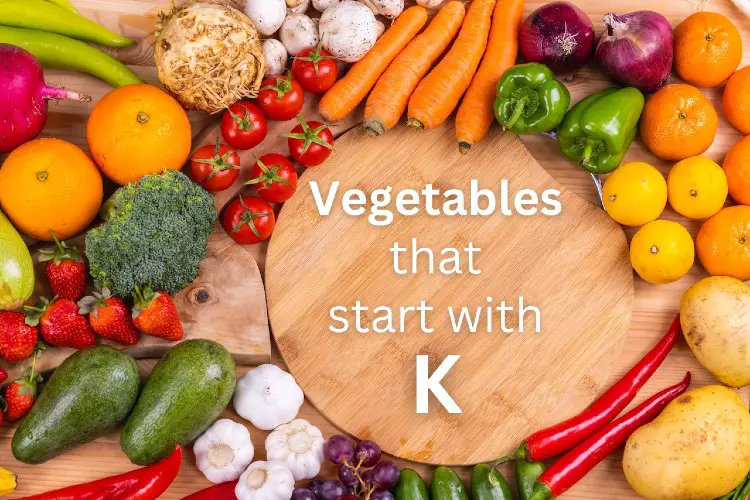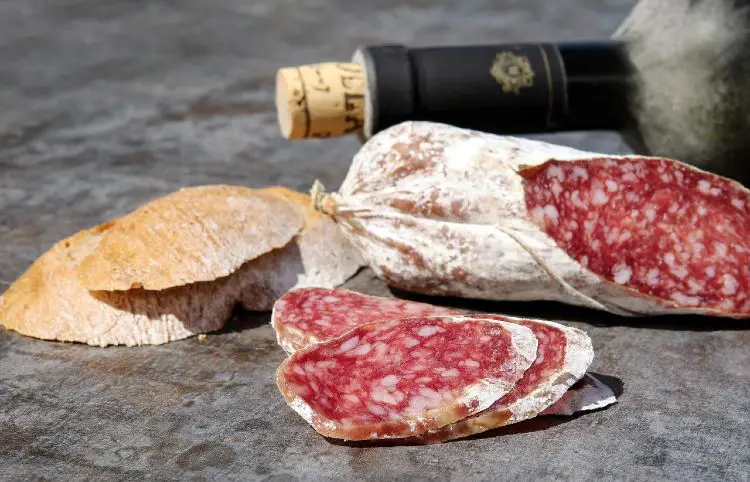Vegetables That Starts with K
Welcome to our comprehensive list of vegetables that start with the letter K!
Whether you’re seeking kale or kidney beans, we’ve got you covered with a collection of amazing veggies.
Our list includes a variety of vegetables starting with K, and we’ve provided detailed information, along with links to recipes, so you can explore and enjoy these vegetables to the fullest.
But wait, there’s more! If you happen to know of any other vegetables that start with K that we might have missed, we would love to hear from you. Leave a comment, and we’ll gladly add them to our list of veggies beginning with K.
Get ready to discover and savor a wide range of delicious vegetables that all share a common trait – their names start with the letter K!
Vegetables Beginning With K
Here is the list of vegetables starting with K.
- Kurrat
- Kabocha Squash
- Kai Lan
- Kale
- Kelp
- Kidney Beans
- Kohlrabi
- Komatsuna
- Kombu
- Kovakkai
- Kyona
- Kusamochi
Details of Vegetables Starting with Letter K
Kurrat
Kurrat, also known as Egyptian leek, is a vegetable that belongs to the Allium family. It has a flavor profile similar to leeks and garlic, with a mild onion-like taste.
Kurrat is commonly used in Middle Eastern and Egyptian cuisines, where it is used in various dishes such as stews, soups, and salads. It can be cooked or eaten raw.
Kurrat is a good source of vitamins A and C, as well as dietary fiber. It provides unique flavor and adds versatility in cooking.
Kabocha Squash
Kabocha squash is a type of winter squash with a sweet and nutty flavor. It has a dense, smooth texture and a vibrant orange flesh.
Kabocha squash is commonly used in Japanese and Asian cuisines. It can be roasted, steamed, or used in soups, stews, and tempura.
The skin is often left on when cooking, as it becomes tender and adds additional flavor.
Kabocha squash is rich in vitamins A and C, as well as dietary fiber. People love it for its delicious taste and its versatility in both sweet and savory recipes.
Kai Lan
Kai lan, also known as Chinese broccoli or Chinese kale, is a leafy green vegetable commonly used in Chinese cooking.
It has dark green leaves and thick stems. Kai lan has a slightly bitter taste, similar to broccoli, with a hint of sweetness.
It is often stir-fried, blanched, or used in soups and stews.
Kai lan is a good source of vitamins A, C, and K, as well as calcium and iron. It is has good nutritional value and adds a unique flavor and texture to dishes.
Kale
Kale is a leafy green vegetable that has gained popularity in recent years due to its nutritional benefits. It has dark, curly leaves and a slightly bitter taste.
Kale is packed with vitamins, minerals, and antioxidants. It can be used in a variety of dishes, including salads, smoothies, soups, and stir-fries.
Kale can be enjoyed raw or cooked, and its flavor becomes milder when cooked. It is a versatile ingredient that adds a vibrant green color and a nutritious element to meals.
Kelp
Kelp is a type of seaweed that is commonly consumed in many Asian cuisines, particularly in Japan. It has a brownish color and a slightly salty taste.
Kelp is rich in minerals, including iodine, calcium, and potassium.
It is used in various forms, such as dried kelp sheets (nori), kelp powder, or as an ingredient in soups, salads, and sushi.
Kelp is valued for its umami flavor and its nutritional content. It is believed to have health benefits, including supporting thyroid function and promoting healthy digestion.
Kidney Beans
Kidney beans are a type of legume with a distinct kidney shape. They are commonly used in various cuisines, including Mexican, Indian, and Caribbean.
Kidney beans have a hearty, meaty texture and a mild, nutty flavor.
They are a good source of plant-based protein, dietary fiber, and minerals. Kidney beans are used in stews, soups, salads, and as a filling for burritos and tacos.
They can be cooked from dried form or used from canned beans for convenience.
Kidney beans are popular for their versatility, nutritional value, and ability to add texture and flavor to dishes.
Kohlrabi
Kohlrabi is a vegetable that belongs to the Brassica family, which includes cabbage, broccoli, and kale.
It has a unique appearance with a round bulbous shape and stems that extend into leafy greens.
Kohlrabi has a crunchy texture and a slightly sweet, mild flavor.
It can be eaten raw in salads or slaws, as well as cooked by roasting, steaming, or sautéing. K
Kohlrabi is rich in vitamins C and B6, as well as dietary fiber. People like it for its refreshing taste and its ability to be used in both raw and cooked preparations.
Komatsuna
Komatsuna, also known as Japanese mustard spinach, is a leafy green vegetable commonly used in Japanese and Asian cuisines.
It has smooth, dark green leaves and a tender texture. Komatsuna has a mild, mustard-like flavor with a slight sweetness.
It can be used in salads, stir-fries, soups, and pickles.
Komatsuna is a good source of vitamins A, C, and K, as well as calcium and iron.
It is popular for its delicate taste and its versatility in both raw and cooked dishes.
Kombu
Kombu is a type of edible kelp commonly used in Japanese cuisine, particularly in making dashi, a traditional soup stock. It has a thick, leathery texture and a slightly salty taste.
Kombu is rich in minerals, including iodine, calcium, and potassium.
It is typically used in its dried form and added to soups, stews, and simmered dishes to enhance umami flavors.
Kombu is also used to wrap rice balls and as a topping for rice dishes. People love it for its unique flavor and its contribution to the savory taste in Japanese cuisine.
Kovakkai
Kovakkai, also known as ivy gourd or tindora, is a small, elongated vegetable commonly used in Indian and Southeast Asian cuisines.
It has a crunchy texture and a slightly tangy taste.
Kovakkai is often used in stir-fries, curries, pickles, and chutneys. It can be cooked with spices and other vegetables to create flavorful dishes.
Kovakkai is a good source of dietary fiber, vitamins, and minerals.
It adds a crunchy element to Indian and Asian recipes.
Kyona
Kyona, also known as Japanese mustard greens, is a leafy green vegetable commonly used in Japanese cuisine.
It has broad, serrated leaves and a spicy, peppery flavor. Kyona is often used in salads, stir-fries, and pickled preparations.
It adds a distinct zing and a vibrant green color to dishes.
Kyona is a good source of vitamins A, C, and K, as well as antioxidants.
People enjoy it for its spicy kick and its ability to add a punch of flavor to Japanese dishes.
Kusamochi
Kusamochi is a type of Japanese sweet made from glutinous rice flour and mugwort, a type of herb.
It has a chewy texture and a slightly bitter, earthy taste.
Kusamochi is often shaped into small, round dumplings and coated with soybean flour.
It is commonly enjoyed during festivals and celebrations in Japan. Kusamochi is appreciated for its unique flavor and its cultural significance in Japanese cuisine.
That concludes our list of “Vegetables that start with K“! We hope you found it informative and helpful for your culinary endeavors.
We value your input! If you think there are any vegetables beginning with K we may have missed, please let us know in the comments section below.

